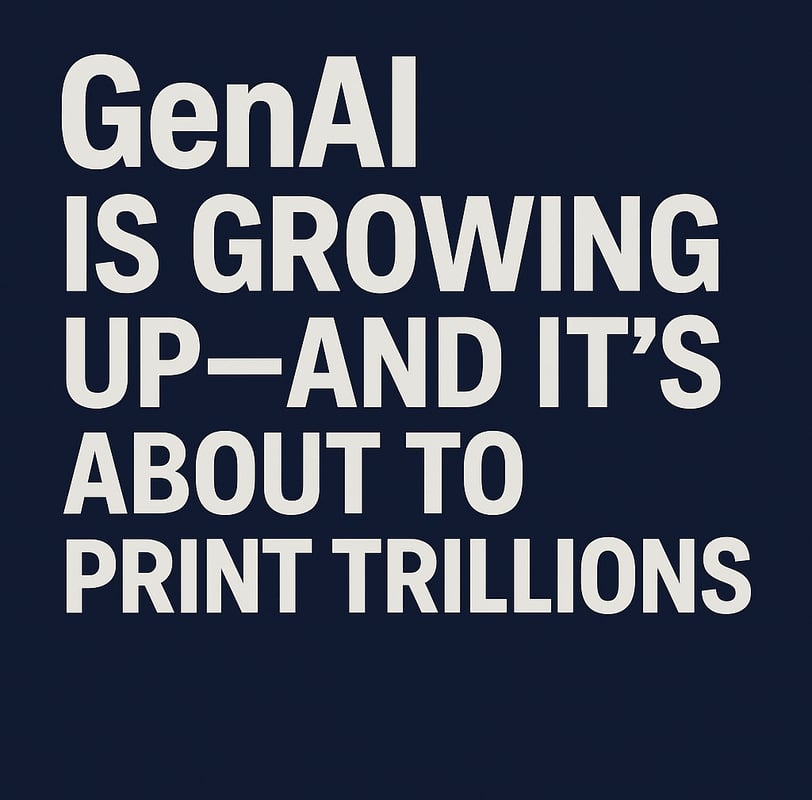GenAI’s $1 Trillion Future — And Why 2025 Is the Breakout Year
Generative AI is no longer hype—it’s driving real revenue, reshaping enterprise workflows, and creating trillion-dollar opportunities. This post breaks down key insights from two GenAI forecasts and how smart companies are helping clients turn AI potential into business outcomes.
DATA & AITECHNOLOGYBUSINESS
Jake Byford
4/14/20252 min read


In 2022, GenAI exploded onto the scene.
In 2023, companies scrambled to experiment.
In 2024, the tech proved it works.
Now?
2025 is the year GenAI starts printing money.
Generative AI isn’t hype anymore.
It’s hard work.
It’s infrastructure.
It’s a trillion-dollar engine in the making.
Two major reports recently dropped.
Morgan Stanley’s GenAI forecast
Deloitte’s Q4 2024 GenAI forecast
Here’s what you need to know.
Morgan Stanley says GenAI revenue will grow from $45 billion in 2024 to $1.1 trillion by 2028.
That’s 25x in four years.
2025 is the breakout year.
Profitability kicks in with a 34% contribution margin.
That’s $51 billion in net returns.
By 2028: $722 billion in profit.
Hardware’s heating up too.
Semiconductor spending will hit $280 billion.
Networking and memory? Another $276 billion.
This isn’t a bubble.
It’s the next economic engine.
Deloitte paints a more grounded picture.
Tech is sprinting.
Companies? Not quite.
Most are running fewer than 20 GenAI pilots.
Only 30% plan to scale even a third of them.
Less than 40% of employees have access.
IT leads in use cases, but marketing, ops, and cybersecurity are closing in.
Execs are bullish.
Employees are cautious.
Culture and trust are still playing catch-up.
There are bright spots.
Seventy-four percent of companies say their most advanced GenAI projects are meeting or beating expectations.
Cybersecurity is leading the pack.
Forty-four percent of cyber-related initiatives are outperforming.
And companies are finding more value in innovation than just productivity.
GenAI isn’t just saving time—it’s helping uncover new ideas.
More than half of organizations are exploring autonomous AI agents.
Multi-agent systems.
Multimodal models.
The vision: AI that acts on its own.
Not just responding—deciding.
But challenges remain.
Real-world errors.
Missed expectations.
Bad data.
Most companies admit it’ll take another one to two years to tackle governance, trust, and workforce readiness.
What are smart companies doing?
Leaders are stepping up.
Less cheerleading.
More championing.
They’re aligning expectations.
Encouraging collaboration.
Owning the risk.
The winning playbook:
Train your people.
Give them access.
Start laying the foundation for agents now.
In banking, GenAI cut millions of cyber security alerts at a leading bank to fewer than 10 a day.
In tech, sales reps are closing faster using auto-generated proposals.
In consumer goods, a brand generated Emmy night posts in real-time—no writers needed.
This isn’t just about adoption.
It’s about execution.
The winners won’t be the ones with the loudest headlines.
They’ll be the ones who iterate fast, train hard, and build with purpose.
Let’s move.
— Jake
At my company, we’re not just watching this shift—we’re helping shape it.
We lead with domain expertise.
We build AI-first solutions.
We align GenAI initiatives to real business problems—not hype.
We deliver domain-specific AI and data products that drive outcomes.
Whether it’s in financial services, healthcare, or telecom we focus on solutions over experiments. That’s how you win in the GenAI era.
